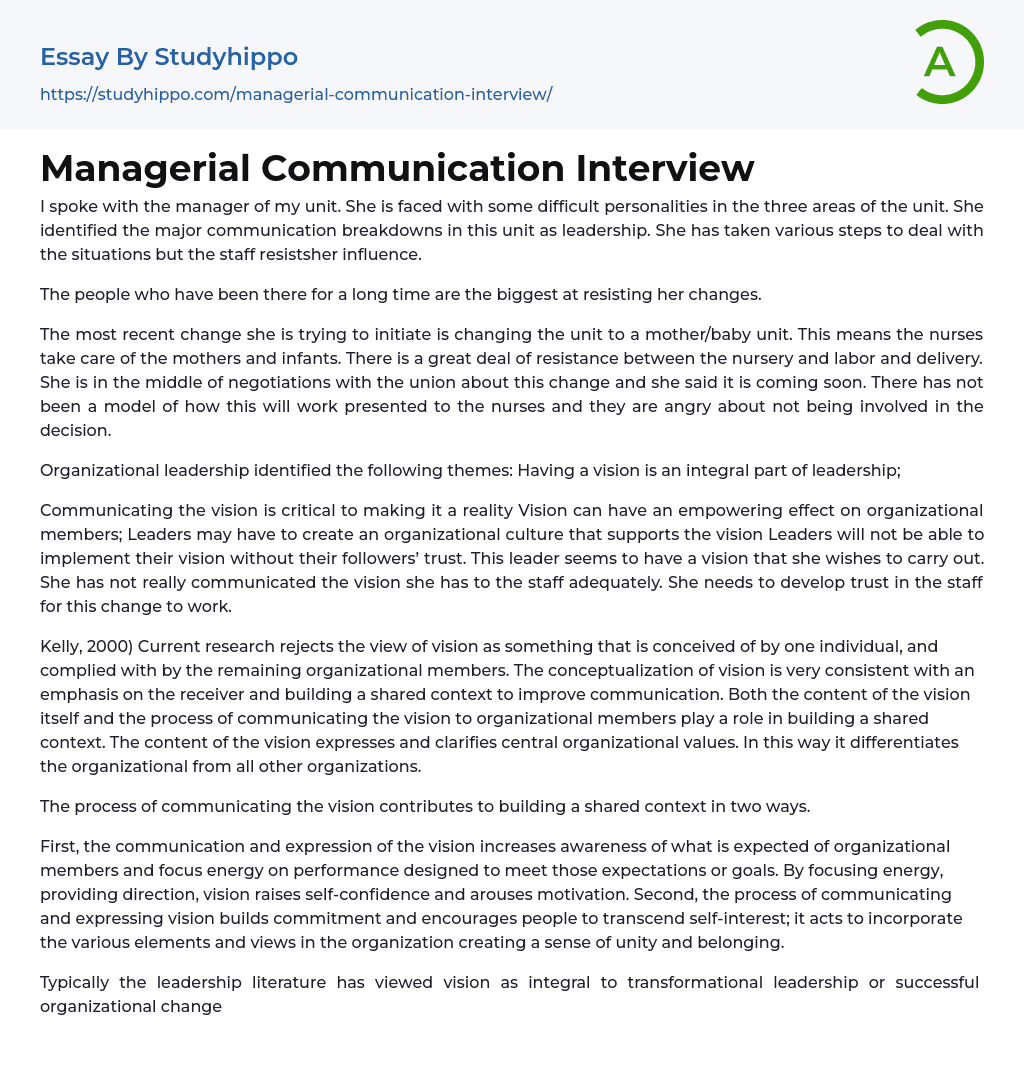During my conversation with the manager of my unit, it was revealed that she is encountering a challenge concerning difficult personalities in three areas of the unit. Leadership was identified as the major cause of communication breakdowns in the unit. Despite taking measures to tackle these issues, the staff remains resistant to her efforts to implement change.
In her efforts to bring change to the unit, she is pushing for a switch to a mother/baby unit where nurses will care for both mothers and infants. The nursery and labor and delivery departments are resisting this change, and negotiations with the union are ongoing. The change is expected to occur soon, but the nurses are upset about not being included in the decision-making process as they have yet to see a plan for how this new system will function.
Organizational leadership identified the fo
llowing themes: Having a vision is an integral part of leadership;
Effective communication of a vision is vital for its realization, as it can empower members of an organization. Leaders must foster a culture that aligns with the vision and earns the trust of followers to successfully implement it. However, in this situation, the leader has yet to adequately communicate their vision to the staff and must build trust in the team for the intended change to succeed.
There are two ways in which sharing the vision helps to create a common context.
The leadership literature commonly regards vision as vital for transformational leadership and successful organizational change, not only for communicating grand strategies or revolutionary change, but also for everyday context building in organizations. Therefore, it shoul
be considered as an additional means of enhancing organizational communication.
Illustrating to employees how the plan will operate will motivate them to embrace the vision and overcome any resistance. It is crucial to involve staff in the dialogues and formulation of policies to establish the new benchmarks. The central contradiction lies in the fact that this notion impacts two tiers – the organization and its members. The organization represents a community of individuals who collaborate for the betterment of the enterprise.
All organizations deal with a fundamental tension that keeps the sense of communication open.
The organization's goals were centered around control and coordination, necessitating a shift from independence to interdependence. It is crucial for the organization to cater to its members' individual requirements while compelling them to act towards achieving the organization's objectives. The strategies employed by the organization for organizing may differ, but there is uniformity in the way its departments function.
They need to attract the employee’s visions of the manager and develop them into similar views.
To enhance communication between management and staff, it is crucial to adopt a approach that takes into account the opinions of both parties (Conrad, Scott Poole, 2005). Open communication is crucial for the employees to satisfy the expectations of management. It is important to prioritize both employees' and management's expectations as fundamental strategies and achieve mutual understanding between the two sectors.
The manager cannot just put in place a plan without meeting a great deal of resistance.
To effectively communicate, it is important to have regular meetings and listen to staff feedback. Management should also share their thoughts and plans about any changes. The manager
may need to negotiate with the union to ensure fairness. It is crucial to involve employees in developing new policies and addressing any questions that may arise.
The state mandates that the employees can possess four pairs consisting of a mother and a baby, totaling to eight individuals in all.
In order to advertise the unit effectively, it is important to involve the staff and gather their opinions. While the manager has the ultimate decision-making power, it is crucial for her to consider the feedback and input of those who will be responsible for staffing the unit.
References
- Charles Conrad Marshall Scott Poole. (2005).
- Strategic Organizational Communication. Wadsworth. Dawn Kelly (2000).
- Using vision to improve organizational communication.Leadership and Organization Development Journal. (21)2
- Greeting essays
- Orality essays
- Intercultural Communication essays
- Interpersonal Communication essays
- Cross-Cultural Communication essays
- Nonverbal Communication essays
- Effective Communication essays
- Communication Skills essays
- Being A Leader essays
- Servant Leadership essays
- Leadership Experience essays
- Leadership Qualities essays
- Arranged Marriage essays
- Communication essays
- Conflict Management essays
- Conflict Resolution essays
- Connection essays
- Conversation essays
- Dating essays
- Friendship essays
- Mediation essays
- Career Choice essays
- Career Goals essays
- Career Plan essays
- Community Service essays
- Dream Job essays
- Duty essays
- Employee essays
- Internship essays
- Interview essays
- Job essays
- Job Interview essays
- Performance Appraisal essays
- Portfolio essays
- Service essays
- Skills essays
- Vocation essays
- Work Experience essays
- Work-Life Balance essays
- Board Of Directors essays
- Brand Management essays
- Business Ethics essays
- Business Management essays
- Change Management essays
- Comparative Analysis essays
- Decision Making essays
- Dispute Resolution essays
- Knowledge Management essays
- Leadership essays
- Leadership and Management essays




